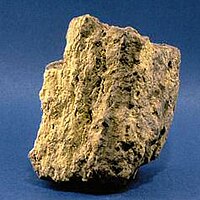
Photo from wikipedia
Abstract The Koprubasi uranium deposit is the largest known uranium deposits in Turkey. Uranium mineralization is hosted in Neogene fluvial sediments that consist of predominantly sandstone and conglomerate interlayered with… Click to show full abstract
Abstract The Koprubasi uranium deposit is the largest known uranium deposits in Turkey. Uranium mineralization is hosted in Neogene fluvial sediments that consist of predominantly sandstone and conglomerate interlayered with siltstone, claystone and mudstone. Sediments were primarily derived from metamorphic rocks adjacent to the basins of deposition, with some volcanic contribution in the form of tuffs. The sandstones and conglomerates are the most widespread sediments within the study area and host the majority of the U ore. X-ray diffraction (XRD) and scanning electron microscopy (SEM) with energy-dispersive X-ray spectroscopy (EDX) analysis were used to identify the ore and associated minerals. The uranium ore minerals of the host sedimentary rocks are torbernite, meta-torbernite and meta-autunite. These coexist with jarosite, various clays (chlorite/kaolinite, illite, and smectite), and Fe- and Mn-(hydr) oxides with minor titanium oxide. Additionally, quartz, feldspars and a minor amount of mica (muscovite and biotite) are the main primary minerals in the sedimentary rocks. The uranyl phosphates coat the surfaces of pebbles and some mineral grains, fill cracks, and are disseminated within the pores of the host sedimentary rocks. Uranyl phosphates are commonly associated with Fe-(hydr) oxides and clays, although some were observed in millimeter- or centimeter wide gaps within Koprubasi sediments. Oxides of manganese are also locally abundant and associated with uranyl phosphates. The uranyl phosphates in the sediments of the Koprubasi area most likely formed when oxidizing groundwater moved through the host rock. The common association of uranyl phosphates with Fe-(hydr) oxides and clays suggests that the precipitation of uranyl phosphate minerals is mainly due to adsorption of the uranyl and phosphate to the surface of Fe-(hydr) oxides and clays.
Journal Title: Ore Geology Reviews
Year Published: 2017
Link to full text (if available)
Share on Social Media: Sign Up to like & get
recommendations!